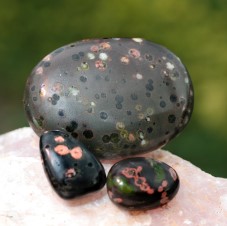_____________________
A dark basalt from Michigan (USA) with roundish cavities, filled with colorful minerals has been given the trade name »Rainbow Basalt«.
Basaltic rocks are formed wherever thin, low-silica magma emerges at the earth's surface in volcanically active zones and cools down relatively quickly to basalt lava. Beside very fine-grained plagioclase feldspars and pyroxene minerals, olivine and magnetite may also be present, as well as an uncrystallized glassy component. Sometimes basalt lavas are quite rich in gaseous components. Therefore roundish cavities are frequently found.
The analysis of some thin sections of the »Rainbow Basalt« showed highly weathered minerals. The initial cavities are now filled with partially complex mineralizations.
Besides feldspar we found calcite and small quartz crystals. To some extent the feldspar is decomposed into clay minerals. In addition, zeolite minerals have been found.
The differences in color of the roundish cavity fillings can be explained by the presence of iron oxides (hematite, goethite), which are responsible for the reddish colors. Zeolites as well as weathered feldspar give a greenish tint.
The groundmass surrounding the filled cavities is homogeneous and consists mostly of plagioclase feldspar. In between serpentinized olivines, isolated augites can be found. The abounded iron oxides orininate probably of magnetite, decayed into some hematite and plenty of goethite. A glassy component between the crystals indicates an age of less than 150 million years.
Thus »Rainbow Basalt« is a relatively young basalt. It found its way into the jewelry industry due to his aesthetically attractive colorful cavity fillings.




